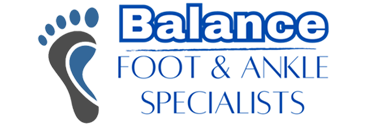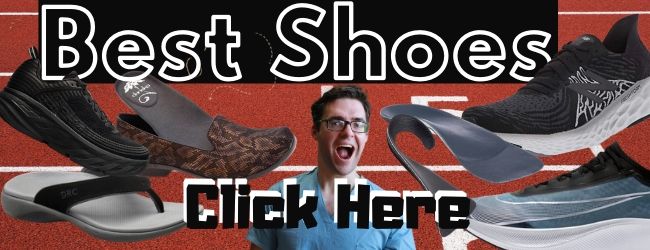Heel Pain After Running [Best Orthotics, Best Shoes & Home Treatment]
Heel Pain After Running: The best home treatment includes #1) Low cost orthotics, #2) Great shoes, #3) The right stretching & #4) Massage the tissue.
Look:
- Heel pain can be improved with a few simple treatment changes.
- We are foot doctors & we see this problem get better almost every day.
- The goal is to solve this problem without medication or surgery if possible.
So, let’s GO!
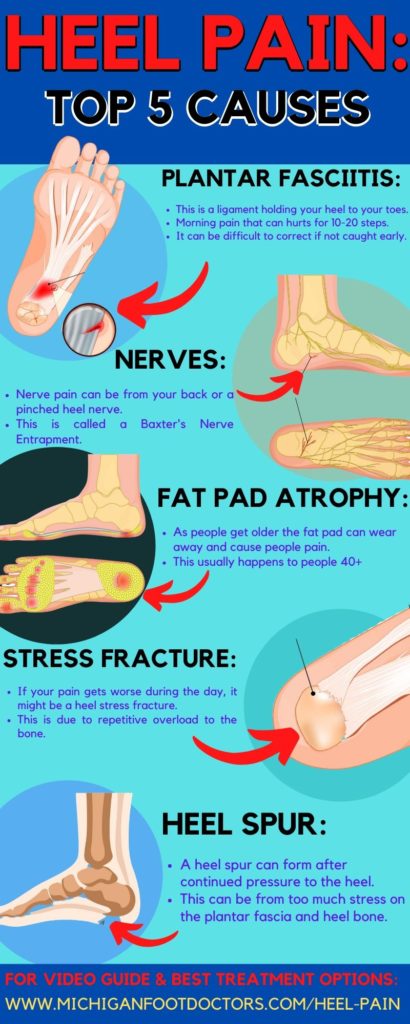
Heel Pain Causes: Picture & Photo Gallery
Look:
- One of the top causes of heel pain is plantar fasciitis. This is damage to a ligament that holds your heel to your toes.
- Another root cause of heel pain has flat feet.
- There are also photos of heel spurs that can occur to the bottom of your heel (plantar fascia insertion) and the back of your heel (Achilles tendon insertion).
- Baxter’s nerve entrapment can also happen at the bottom of the heel.
- An underlying cause is an overpronated flatfoot or an over a supinated high arched foot.
- A plantar fibroma is a thick nodule that can occur within your plantar fascia ligament and contribute to plantar fasciitis.
- This can lead to the formation of a heel stress fracture( AKA calcaneus stress fracture.)
Please click on the gallery for a guided tour through heel pain conditions!
Causes:
There Are 2 major types of heel pain after running:
- Back of heel pain after running and bottom of the heel pain after running.
- Luckily both types of pain are caused and treated the same way!
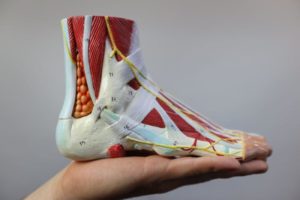
1)Bottom Of The Heel Pain After Running:
- Heel pain after running is almost always caused by the pull of the plantar fascia.
- With each step you take it pulls away from the heel bone.
- This ligament undergoes a large amount of stress results in many microscopic tears.
- These tears begin to ache after running.
- They will hurt even more when you wake up the next morning!
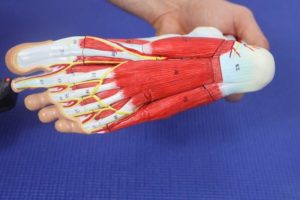
Running Heel Pain Can Lead To Heel Spurs:
- If not corrected, plantar fascia over time can lead to a heel spur.
Bottom Of The Heel Pain After Running Treatment:
Treatment is based on 3 principles:
1)Decreasing the inflammation.
2)Correcting improper biomechanics.
- This takes stretching & exercises.
3)Get the right shoes and measure them correctly!
2) Back of Heel Pain After Running:
- Pain at the back of the heel is caused by the pull of the Achilles tendon.
- This is the largest tendon in the body and cause cause irritation in the back of the heel.
- Achilles tendinitis and plantar fasciitis are the two most common types of running pain.
Achilles Heel Pain After Running:
- Overuse and stress of the achilles tendon can cause inflammation.
- Luckily Achilles heel pain after running is treated the same way as plantar fasciitis.
Heel Pain After Running Causes:
- If the achilles tendon and the plantar fascia are too tight, you will get heel pain!
- If the two ligaments are properly stretched, you will be able to start moving again without heel pain.
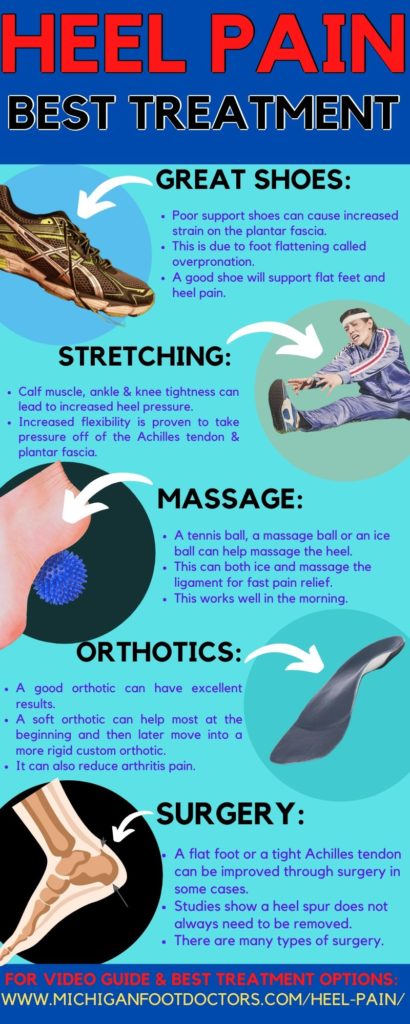
Best Heel Pain Products:
- There are usually two phases to treating plantar fasciitis pain.
- The two phases of treatment include controlling the acute inflammation, and correcting the biomechanics which led to the problem in the first place.
- If the tendons and ligaments are inflamed, they are almost frozen in place and cannot function properly.
- Once the inflammation is decreased, we need to correct the bio-mechanical causes to ensure that they can never become over worked and inflamed again!
- This doesn’t matter whether it’s plantar fasciitis, plantar fibroma, sore bottom of foot, or even Achilles tendon pain. Treatment is all roughly very similar.
Plantar Fasciitis or Achilles Tendonitis Inflammation:
Massage & Ice Products:
- Ice is the an excellent option that can be safe for almost everyone.
- There is some debate whether icing is worth doing, but for chronic pain this can help limit the need for medications and keep your options open.
- This works great for your arch, less for the ball of the foot.
- The more muscle and ligament tissue there is, the better ice will work there.
Best Foot & Ankle Manual Massage Devices:
Best Premium Massage Roller
Most Cost Effective Massage Roller.
Cost Effective Freezable Massage Roller.



Price:
Price not available
$7.99
$11.99
Overview:
Premium freezable metal ball that stays cold for up to 6 hours. Great for plantar fascia, neck, shoulders and calf muscles.
Amazing Price, Great Reviews – Non-Freezable Massage Rolling Stick
Great price and it is freezable. Budget friendly freezable massage roller.
Pros:
Great reviews – near 5 star. Stays cold for a long time with deep penetrating plantar fascia massage. Used by professional athletes. Stays cold for HOURS!
Great for what it does. You roll it back and forth along your plantar fascia massaging the swelling and irritation out. Decreases pain. Thousands of 5 star reviews on Amazon.
Excellent reviews. It massages and ices, so it is a step up over the massage rollers. Near 5 star reviews with >500 reviews.
Cons:
More expensive than some of the other options, but near perfect reviews.
Is not freezable like the other two options. Massaging a sore muscle without the cold sensation can be very painful and render it useless to you if really sore.
It does a great job doing what it is supposed to do. Main downside is that it does not stay cold as long as the premium metal ball.
Important Tips:
Use it with a sock to start (could be too cold). Massaging and icing definitely loosens you up and makes you feel better, but you still have to prevent the pain in the first place. You still need stretching, orthotics and good shoes to prevent the initial damage.
Two things: Without the freezing component, it may be really painful for a very sore arch (So make sure to use ICE also). Also this only reduces pain, it does not stop the cause! You still need good orthotics, shoes and stretching to stop the pain in the first place!
Start with socks at first, especially if you have peripheral neuropathy => don’t freeze your foot! Remember that you still need good orthotics, good shoes and inserts as well as temporary activity reduction.
Affiliate Link (Buying through these links will connect you to Amazon):
Best Foot & Ankle Manual Massage Devices:
Best Premium Massage Roller

Price:
Price not available
Overview:
Premium freezable metal ball that stays cold for up to 6 hours. Great for plantar fascia, neck, shoulders and calf muscles.
Pros:
Great reviews – near 5 star. Stays cold for a long time with deep penetrating plantar fascia massage. Used by professional athletes. Stays cold for HOURS!
Cons:
More expensive than some of the other options, but near perfect reviews.
Important Tips:
Use it with a sock to start (could be too cold). Massaging and icing definitely loosens you up and makes you feel better, but you still have to prevent the pain in the first place. You still need stretching, orthotics and good shoes to prevent the initial damage.
Affiliate Link (Buying through these links will connect you to Amazon):
Best Foot & Ankle Manual Massage Devices:
Most Cost Effective Massage Roller.

Price:
$7.99
Overview:
Amazing Price, Great Reviews – Non-Freezable Massage Rolling Stick
Pros:
Great for what it does. You roll it back and forth along your plantar fascia massaging the swelling and irritation out. Decreases pain. Thousands of 5 star reviews on Amazon.
Cons:
Is not freezable like the other two options. Massaging a sore muscle without the cold sensation can be very painful and render it useless to you if really sore.
Important Tips:
Two things: Without the freezing component, it may be really painful for a very sore arch (So make sure to use ICE also). Also this only reduces pain, it does not stop the cause! You still need good orthotics, shoes and stretching to stop the pain in the first place!
Affiliate Link (Buying through these links will connect you to Amazon):
Best Foot & Ankle Manual Massage Devices:
Cost Effective Freezable Massage Roller.

Price:
$11.99
Overview:
Great price and it is freezable. Budget friendly freezable massage roller.
Pros:
Excellent reviews. It massages and ices, so it is a step up over the massage rollers. Near 5 star reviews with >500 reviews.
Cons:
It does a great job doing what it is supposed to do. Main downside is that it does not stay cold as long as the premium metal ball.
Important Tips:
Start with socks at first, especially if you have peripheral neuropathy => don’t freeze your foot! Remember that you still need good orthotics, good shoes and inserts as well as temporary activity reduction.
Affiliate Link (Buying through these links will connect you to Amazon):
Menthol Based Gels:
- Biofreeze is one of our favorites.
- These gels have been studied to work 2x as long as ice.
- This works great for the ball of the foot.
- This can be very effective for bottom of the heel and Achilles tendon sore regions.
Best Foot & Ankle Muscle/Ligament Pain Relief Products
Best & Proven Pain Relieving Gel.
Roll On Version of Biofreeze Gel.
A giant container of value size biofreeze.
Menthol Based Ointment with Hemp Extract




Price:
Price not available
$27.00
Price not available
$19.99
Overview:
The Proven and Scientifically Published Menthol Based Gel
Same as biofreeze gel, but the roll-on is prefered by some people for their feet, less messy.
8.1 lbs(3.67 kg) of Value Sized Biofreeze!
This is an alternative cream: Basically Biofreeze + hemp extract.
Pros:
Scientifically proven to loosen up and relief pain up to 2x longer than Ice. Less effort than ice and great reviews. 900+ 5 star reviews on Amazon.
The roll-on application of this biofreeze can be easier to apply. Less overall mess.
If you know you already love it and trust the reviews. This is a great value that lasts a long time.
It has great reviews, loved by the all natural crowd. 100s of 5 star reviews with a near perfect rating.
Cons:
Don’t put this on open sores or mucous membranes, it will burn! It can run out quick and doesn’t prevent pain, just helps it.
Not as easy to spread in other areas, main difference is the roll on applicator, same solution.
A gigantic bottle that could fall over and injure you! Seriously this could be too big in some situations.
Basically looks like menthol(active Biofreeze ingredient), but with hemp extract SKYROCKETING the price.
Important Tips:
Menthol is the active ingredient in this and other hemp based creams. It works similar to ice, but once you apply it you can just move on rather than waiting 20 minutes. **Works great to get your through the night if you have pain sleeping**
Roll-on method is best for the bottom of the feet. No other real advantage. Most patients like it prior to bed for easy sleeping without foot pain.
If you know you love it, this stuff works all over the sore areas in your body not just your foot. I have had many people get me to order this for them in the past and LOVED IT!
The hemp extract is almost nothing and likely a marketing gimmick. It’s basically Biofreeze with some hemp extract raising the price.
Affiliate Link (Buying through these links will connect you to Amazon):
Best Foot & Ankle Muscle/Ligament Pain Relief Products
Best & Proven Pain Relieving Gel.

Price:
Price not available
Overview:
The Proven and Scientifically Published Menthol Based Gel
Pros:
Scientifically proven to loosen up and relief pain up to 2x longer than Ice. Less effort than ice and great reviews. 900+ 5 star reviews on Amazon.
Cons:
Don’t put this on open sores or mucous membranes, it will burn! It can run out quick and doesn’t prevent pain, just helps it.
Important Tips:
Menthol is the active ingredient in this and other hemp based creams. It works similar to ice, but once you apply it you can just move on rather than waiting 20 minutes. **Works great to get your through the night if you have pain sleeping**
Affiliate Link (Buying through these links will connect you to Amazon):
Best Foot & Ankle Muscle/Ligament Pain Relief Products
Roll On Version of Biofreeze Gel.

Price:
$27.00
Overview:
Same as biofreeze gel, but the roll-on is prefered by some people for their feet, less messy.
Pros:
The roll-on application of this biofreeze can be easier to apply. Less overall mess.
Cons:
Not as easy to spread in other areas, main difference is the roll on applicator, same solution.
Important Tips:
Roll-on method is best for the bottom of the feet. No other real advantage. Most patients like it prior to bed for easy sleeping without foot pain.
Affiliate Link (Buying through these links will connect you to Amazon):
Best Foot & Ankle Muscle/Ligament Pain Relief Products
A giant container of value size biofreeze.

Price:
Price not available
Overview:
8.1 lbs(3.67 kg) of Value Sized Biofreeze!
Pros:
If you know you already love it and trust the reviews. This is a great value that lasts a long time.
Cons:
A gigantic bottle that could fall over and injure you! Seriously this could be too big in some situations.
Important Tips:
If you know you love it, this stuff works all over the sore areas in your body not just your foot. I have had many people get me to order this for them in the past and LOVED IT!
Affiliate Link (Buying through these links will connect you to Amazon):
Best Foot & Ankle Muscle/Ligament Pain Relief Products
Menthol Based Ointment with Hemp Extract

Price:
$19.99
Overview:
This is an alternative cream: Basically Biofreeze + hemp extract.
Pros:
It has great reviews, loved by the all natural crowd. 100s of 5 star reviews with a near perfect rating.
Cons:
Basically looks like menthol(active Biofreeze ingredient), but with hemp extract SKYROCKETING the price.
Important Tips:
The hemp extract is almost nothing and likely a marketing gimmick. It’s basically Biofreeze with some hemp extract raising the price.
Affiliate Link (Buying through these links will connect you to Amazon):
Massage Sticks:
- These can work great for loosening your muscles.
- This allows less tightness and pressure on the ball of your foot.
- This is very effective for the arch, the gastrocnemius or calf muscle and for the hamstring and thigh muscles.
- This also works very well for the gluteus muscles if you are having butt cheek or hip pain.
Leg & Calf Muscle Massage Roller Sticks:
Best Overall Muscle Massage Stick
Best Cost Effective Massage Roller.
Best & Most Affordable Foot Massage Unit



Price:
$39.95
Price not available
Price not available
Overview:
This is a great option because hair or skin never gets pinched between the wheels. Softer interface.
Great option for an amazing cost. Not as sturdy and comfortable as the tiger tail.
A well reviewed foot massage unit.
Pros:
Best reviews. Hair and skin cannot get pinched. Almost instantly makes you less tender and more flexible. This is a professional grade massage roller.
Amazing reviews for the price point. It essentially does the same job. Muscles feel great afterward. Same overall benefit.
Amazing reviews averaging almost 5 stars. Reasonable price compared to most other units. Relieves swelling and inflammation in your feet naturally.
Cons:
If truly injured (break or tear) this won’t fix your pain. But no real downsides as far as what a massage roller does. Reviews are near perfect.
Wheels and handles can come loose. As a result it can gap and pinch skin and leg hairs. Not as durable as the other roller recommended here.
A more expensive version of manual and ice massage. The extra $ is basically to remove the manual labor yourself if you are OK with that!
Important Tips:
Studies show how effective massage rollers are: Use for 30-60 seconds to loosen up tight muscles, and then you can stretch further short term(1-2 hrs). Great for calf, hamstring, thight and IT band muscle stretching.
Same as for the more expensive one. Studies show the real benefits appear in 30-60 seconds per muscle => less sore and more flexible. That is the time to take advantage and play sports/stay loose. Very proven results.
This can actually help loosen up your calf muscles and foot muscles for a better stretch. So take advantage! You will be less sore and more flexible, but the results disappear after 1-2 hours or so!
Affiliate Link (Buying through these links will connect you to Amazon):
Leg & Calf Muscle Massage Roller Sticks:
Best Overall Muscle Massage Stick

Price:
$39.95
Overview:
This is a great option because hair or skin never gets pinched between the wheels. Softer interface.
Pros:
Best reviews. Hair and skin cannot get pinched. Almost instantly makes you less tender and more flexible. This is a professional grade massage roller.
Cons:
If truly injured (break or tear) this won’t fix your pain. But no real downsides as far as what a massage roller does. Reviews are near perfect.
Important Tips:
Studies show how effective massage rollers are: Use for 30-60 seconds to loosen up tight muscles, and then you can stretch further short term(1-2 hrs). Great for calf, hamstring, thight and IT band muscle stretching.
Affiliate Link (Buying through these links will connect you to Amazon):
Leg & Calf Muscle Massage Roller Sticks:
Best Cost Effective Massage Roller.

Price:
Price not available
Overview:
Great option for an amazing cost. Not as sturdy and comfortable as the tiger tail.
Pros:
Amazing reviews for the price point. It essentially does the same job. Muscles feel great afterward. Same overall benefit.
Cons:
Wheels and handles can come loose. As a result it can gap and pinch skin and leg hairs. Not as durable as the other roller recommended here.
Important Tips:
Same as for the more expensive one. Studies show the real benefits appear in 30-60 seconds per muscle => less sore and more flexible. That is the time to take advantage and play sports/stay loose. Very proven results.
Affiliate Link (Buying through these links will connect you to Amazon):
Leg & Calf Muscle Massage Roller Sticks:
Best & Most Affordable Foot Massage Unit

Price:
Price not available
Overview:
A well reviewed foot massage unit.
Pros:
Amazing reviews averaging almost 5 stars. Reasonable price compared to most other units. Relieves swelling and inflammation in your feet naturally.
Cons:
A more expensive version of manual and ice massage. The extra $ is basically to remove the manual labor yourself if you are OK with that!
Important Tips:
This can actually help loosen up your calf muscles and foot muscles for a better stretch. So take advantage! You will be less sore and more flexible, but the results disappear after 1-2 hours or so!
Affiliate Link (Buying through these links will connect you to Amazon):
Remove the Plantar Fascia or Achilles Tendon Stress:
- The key is to prevent future pain.
- This means keeping you active while keeping stress off of your plantar fascia tendon. This will prevent future re-injury and development of plantar fasciitis.
- If you can get rid of the pain and swelling, this will let you start walking normally.
- If you can walk normally, the vast majority of your pain should gradually start to go away.
- The best way to ensure that your plantar fascia, foot and ankle ligaments are not overworked is to support them.
- The best way to support them is to use great orthotics and great shoes.
- Some people may also need to rely on supportive ankle braces and other supportive modalities.
The Best Heel Pain & Plantar Fasciitis Shoes:
- Getting a great supportive pair of shoes will make sure that there is pressure removed from the heel and plantar fascia region.
- This is especially important if you have plantar fasciitis, heel spur pain or Achilles tendonitis.
- Consider shoes combined with a good supportive orthotic for best pain relief!
- The following link will show you what our favorites are.
Best Heel Pain & Plantar Fasciitis Orthotics:
- These are our recommended orthotics for plantar fasciitis.
- Custom orthotics can work very well, but they should not be a first line of treatment.
- There are different types for different shoes.
- Women’s shoes usually need a less bulky orthotic, but allow for less correction.
- A full length orthotic requires a running shoe, boot or comfortable walking/dress shoe.
- We recommend doing everything you can to get a good supportive shoe that can fit a full length orthotic.
- This is the best way to maximize your orthotics for great results.
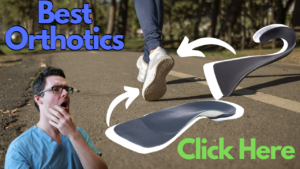
Best Full Length Orthotics:
- These will only work in wider shoes or a good supportive running shoe.
- This will not work in sandals, flats or most women’s dress shoes.
Best Medium to Heavy Duty Heel Pain Orthotics:
Best Overall Orthotic For Everything (Medium Thick Fit)
Best Heavy Duty Orthotic (Thickest Fit)
Best SOFTER Choice For Sensitive Feet (Medium Thick Fit)
Best Women’s Orthotics




Price:
$40.26
$52.88
Price not available
$59.95
Overview:
These work best in shoes with laces and running shoes. Not good for dress shoes or women’s cute shoes.
Biggest and most corrective option. Only use for running shoes or work boots. Not cute shoes.
These are full length inserts, but softer. Great if you can’t tolerate the firmer ones. Best for very sore and sensitive feet.
Great Support & Better Fit
Pros:
Pretty much guaranteed to help you if it fits in your shoes and you give it 2 weeks to get used to. 5,000+ amazon reviews, great track record.
My personal favorite, but not for everyone. Amazing reviews over 3,500. But not for everyone. Only for bigger shoes that can fit them
They are softer and the initial break in time is AMAZING. But longer term benefits are less. >500 Almost 5 star amazon rating.
Sleek, supportive and have a better fit than the orthotics above.
Cons:
Do not wear these in cute or dress shoes!
Bigger and bulkier than all the other ones. You will be dissappointed if you have a cute women’s shoe or dress shoe. This is meant for running shoes and boots.
Great to start with, but don’t correct long term as much as the other ones.
A little bit more expensive.
Crucial Tips:
Ease in to these, 1-2hrs a day. They are like braces for your teeth, they suck at the beginning! But they will make your feet pain free as 1-2 weeks go by. Don’t give up on them after 1 or 2 days. Everyone feels off at the beginning!
This has the most correction, but hardest break in time! IF SENSITIVE, USE A SOFTER PAIR FIRST! But if you get these, you must break them in. Give it 1-2 hours a day, but then you will start to have excellent results. The bad reviews are all people who couldn’t fit it into their shoes and gave up too quickly. You have been WARNED!
If you are very sore, TRY THESE FIRST! These are easiest to break in with initially. If you are very sore and rigid, don’t use the heavy duty ones to start with.
These will have a harder time fitting in flats and pointed shoes.
Affiliate Link (Buying through these links will connect you to Amazon):
Best Medium to Heavy Duty Heel Pain Orthotics:
Best Overall Orthotic For Everything (Medium Thick Fit)

Price:
$40.26
Overview:
These work best in shoes with laces and running shoes. Not good for dress shoes or women’s cute shoes.
Pros:
Pretty much guaranteed to help you if it fits in your shoes and you give it 2 weeks to get used to. 5,000+ amazon reviews, great track record.
Cons:
Do not wear these in cute or dress shoes!
Crucial Tips:
Ease in to these, 1-2hrs a day. They are like braces for your teeth, they suck at the beginning! But they will make your feet pain free as 1-2 weeks go by. Don’t give up on them after 1 or 2 days. Everyone feels off at the beginning!
Affiliate Link (Buying through these links will connect you to Amazon):
Best Medium to Heavy Duty Heel Pain Orthotics:
Best Heavy Duty Orthotic (Thickest Fit)

Price:
$52.88
Overview:
Biggest and most corrective option. Only use for running shoes or work boots. Not cute shoes.
Pros:
My personal favorite, but not for everyone. Amazing reviews over 3,500. But not for everyone. Only for bigger shoes that can fit them
Cons:
Bigger and bulkier than all the other ones. You will be dissappointed if you have a cute women’s shoe or dress shoe. This is meant for running shoes and boots.
Crucial Tips:
This has the most correction, but hardest break in time! IF SENSITIVE, USE A SOFTER PAIR FIRST! But if you get these, you must break them in. Give it 1-2 hours a day, but then you will start to have excellent results. The bad reviews are all people who couldn’t fit it into their shoes and gave up too quickly. You have been WARNED!
Affiliate Link (Buying through these links will connect you to Amazon):
Best Medium to Heavy Duty Heel Pain Orthotics:
Best SOFTER Choice For Sensitive Feet (Medium Thick Fit)

Price:
Price not available
Overview:
These are full length inserts, but softer. Great if you can’t tolerate the firmer ones. Best for very sore and sensitive feet.
Pros:
They are softer and the initial break in time is AMAZING. But longer term benefits are less. >500 Almost 5 star amazon rating.
Cons:
Great to start with, but don’t correct long term as much as the other ones.
Crucial Tips:
If you are very sore, TRY THESE FIRST! These are easiest to break in with initially. If you are very sore and rigid, don’t use the heavy duty ones to start with.
Affiliate Link (Buying through these links will connect you to Amazon):
Best Medium to Heavy Duty Heel Pain Orthotics:
Best Women’s Orthotics

Price:
$59.95
Overview:
Great Support & Better Fit
Pros:
Sleek, supportive and have a better fit than the orthotics above.
Cons:
A little bit more expensive.
Crucial Tips:
These will have a harder time fitting in flats and pointed shoes.
Affiliate Link (Buying through these links will connect you to Amazon):
Best Dress Shoe Orthotics:
- These are a great choice for dress orthotics.
Best Dress Shoe Orthotics:
Best Fitting Dress Shoe Orthotic (3/4″)
Best Full Length Dress Orthotic.
Great Heavy Duty Insole for Men



Price:
Price not available
Price not available
$34.95
Overview:
This is my top choice due to best fit. It is a little less supportive than full length, but fit is the key in dress shoes!
Best option if you can fit a full length orthotic. This does give you most control.
Great price and heavy duty insole for Oxford shoes.
Pros:
Excellent overall fit. This will fit in almost every dress shoe. Excellent reviews and reasonable cost overall. Can’t go wrong in most cases.
Great color dress option. Not the most corrective, but very color and dress appropriate. Great Reviews. Better correction and relief than the 3/4″ length.
These fit in most shoes and have really good predictable results
Cons:
Less correction than full length and heavy duty orthotics.
These can have a poor fit in in some shoes. If you have tight shoes, DO NOT BUY the full length orthotic! You have been warned.
They are not full length and thus do not provide as much support
Crucial Tips:
If you haven’t used dress orthotics before, get this one and avoid poor fit. If you wear dress shoes every day with room, the full length might give you more support.
This is will work great in most men’s shoes that are not pointy. If you have a rounded toe box, this will probably work well. If a tight shoe go with the 3/4″ length.
Get these for Oxford and pointed shoes. This will provide best results.
Affiliate Link (Buying through these links will connect you to Amazon):
Best Dress Shoe Orthotics:
Best Fitting Dress Shoe Orthotic (3/4″)

Price:
Price not available
Overview:
This is my top choice due to best fit. It is a little less supportive than full length, but fit is the key in dress shoes!
Pros:
Excellent overall fit. This will fit in almost every dress shoe. Excellent reviews and reasonable cost overall. Can’t go wrong in most cases.
Cons:
Less correction than full length and heavy duty orthotics.
Crucial Tips:
If you haven’t used dress orthotics before, get this one and avoid poor fit. If you wear dress shoes every day with room, the full length might give you more support.
Affiliate Link (Buying through these links will connect you to Amazon):
Best Dress Shoe Orthotics:
Best Full Length Dress Orthotic.

Price:
Price not available
Overview:
Best option if you can fit a full length orthotic. This does give you most control.
Pros:
Great color dress option. Not the most corrective, but very color and dress appropriate. Great Reviews. Better correction and relief than the 3/4″ length.
Cons:
These can have a poor fit in in some shoes. If you have tight shoes, DO NOT BUY the full length orthotic! You have been warned.
Crucial Tips:
This is will work great in most men’s shoes that are not pointy. If you have a rounded toe box, this will probably work well. If a tight shoe go with the 3/4″ length.
Affiliate Link (Buying through these links will connect you to Amazon):
Best Dress Shoe Orthotics:
Great Heavy Duty Insole for Men

Price:
$34.95
Overview:
Great price and heavy duty insole for Oxford shoes.
Pros:
These fit in most shoes and have really good predictable results
Cons:
They are not full length and thus do not provide as much support
Crucial Tips:
Get these for Oxford and pointed shoes. This will provide best results.
Affiliate Link (Buying through these links will connect you to Amazon):
Best 3/4 Length Orthotics:
- These are great options for women’s dress shoes and thinner shoes.
- These are not the most supportive pair of orthotics.
Best Flat Shoe (Non-Lace Up) Orthotics:
Best Choice For Tight Women’s Shoes or High Heels..

Price:
Price not available
Overview:
These are the best fitting for the most narrow shoes. Some but not great correction.
Pros:
They will fit in even the tightest shoes! Guaranteed to make you feel better, but you know what you are getting in a tight shoes. Great reviews and price.
Cons:
At the end of the day high heels and slender orthotics help, but never cure all your pain. Make the best of a painful shoe!
Crucial Tips:
**WARNING***: If your shoe almost just barely fits onto your foot, this WILL NOT FIT! Be aware, it still needs a small amount of space to fit.
Affiliate Link (Buying through these links will connect you to Amazon):
Best Flat Shoe (Non-Lace Up) Orthotics:
Best Choice For Tight Women’s Shoes or High Heels..

Price:
Price not available
Overview:
These are the best fitting for the most narrow shoes. Some but not great correction.
Pros:
They will fit in even the tightest shoes! Guaranteed to make you feel better, but you know what you are getting in a tight shoes. Great reviews and price.
Cons:
At the end of the day high heels and slender orthotics help, but never cure all your pain. Make the best of a painful shoe!
Crucial Tips:
**WARNING***: If your shoe almost just barely fits onto your foot, this WILL NOT FIT! Be aware, it still needs a small amount of space to fit.
Affiliate Link (Buying through these links will connect you to Amazon):
Get A Great Dynamic Stretch:
- It is possible to stretch on your own, but these products can also really help!
- This will take pressure off of the ball of your foot.
- We personally prefer this method of stretching.
Best Standing Foot & Ankle Stretching Devices:
Best Premium Plantar Fascia Stretching Device.
Best Budget Plantar Fascia Stretching Stretch Device.
Best Stationary Calf Stretching Device.
Best Hamstring Stretching Device




Price:
$39.99
$15.99
$45.95
$69.95
Overview:
Great Stretching Device While Standing. (4.9 Amazon Rating)
Plastic and Lighter Plantar Fascia & Achilles Stretching Device.
Premium Best Rated Wood Ankle Stretch Device.
Uses gravity to stretch your hamstring for you. Great reviews and track record.
Pros:
Very sturdy and durable. Great bottom grip and weight so it won’t slide on you. Perfect 5 star review on Amazon.
Amazing cost, still works and 1,300+ 5 star reviews. Works great overall and gives you the same stretch.
Near perfect 4.8 star review on Amazon. Great sturdy device that stretches your calf and hamstring. All you have to do is lean forward. Can be very effective.
Reviews on Amazon are >4.5 overall with hundreds of reviews. It uses gravity to stretch for you, allows you to also use your hips. Gets great results.
Cons:
More expensive and built like a tank = more weight. If you can’t balance well or support yourself it could be dangerous.
The plastic and less bulk/grip makes it more dangerous to slip. Less premium feel to it.
Nothing wrong with the product, as the reviews suggest, but at the end of the day you can do this stuff yourself (just a little bit harder).
These are stretches that you realistically can do on your own. If budget is tight, this is not worth it. If you need help with hamstring stretching, it can make all the difference.
Important Tips:
Make sure you can balance yourself well against a counter/railing. Do only one foot at a time to prevent falling. Uses your body weight to stretch for you.
Even more important to balance yourself well with this device, make sure you don’t injure yourself with this thing! Still gives you a great stretch to the area.
Make sure you balance yourself on a counter/railing. You need to keep up with this daily at least 15-30 second x 3 or so per morning. It doesn’t stretch for you!
Need to do 3-5 stretches per day 15-30 seconds. You should notice a massive difference to knee and hamstring tightness. You can massage roll ahead to time for better results for 30-60 seconds.
Affiliate Link (Buying through these links will connect you to Amazon):
Best Standing Foot & Ankle Stretching Devices:
Best Premium Plantar Fascia Stretching Device.

Price:
$39.99
Overview:
Great Stretching Device While Standing. (4.9 Amazon Rating)
Pros:
Very sturdy and durable. Great bottom grip and weight so it won’t slide on you. Perfect 5 star review on Amazon.
Cons:
More expensive and built like a tank = more weight. If you can’t balance well or support yourself it could be dangerous.
Important Tips:
Make sure you can balance yourself well against a counter/railing. Do only one foot at a time to prevent falling. Uses your body weight to stretch for you.
Affiliate Link (Buying through these links will connect you to Amazon):
Best Standing Foot & Ankle Stretching Devices:
Best Budget Plantar Fascia Stretching Stretch Device.

Price:
$15.99
Overview:
Plastic and Lighter Plantar Fascia & Achilles Stretching Device.
Pros:
Amazing cost, still works and 1,300+ 5 star reviews. Works great overall and gives you the same stretch.
Cons:
The plastic and less bulk/grip makes it more dangerous to slip. Less premium feel to it.
Important Tips:
Even more important to balance yourself well with this device, make sure you don’t injure yourself with this thing! Still gives you a great stretch to the area.
Affiliate Link (Buying through these links will connect you to Amazon):
Best Standing Foot & Ankle Stretching Devices:
Best Stationary Calf Stretching Device.

Price:
$45.95
Overview:
Premium Best Rated Wood Ankle Stretch Device.
Pros:
Near perfect 4.8 star review on Amazon. Great sturdy device that stretches your calf and hamstring. All you have to do is lean forward. Can be very effective.
Cons:
Nothing wrong with the product, as the reviews suggest, but at the end of the day you can do this stuff yourself (just a little bit harder).
Important Tips:
Make sure you balance yourself on a counter/railing. You need to keep up with this daily at least 15-30 second x 3 or so per morning. It doesn’t stretch for you!
Affiliate Link (Buying through these links will connect you to Amazon):
Best Standing Foot & Ankle Stretching Devices:
Best Hamstring Stretching Device

Price:
$69.95
Overview:
Uses gravity to stretch your hamstring for you. Great reviews and track record.
Pros:
Reviews on Amazon are >4.5 overall with hundreds of reviews. It uses gravity to stretch for you, allows you to also use your hips. Gets great results.
Cons:
These are stretches that you realistically can do on your own. If budget is tight, this is not worth it. If you need help with hamstring stretching, it can make all the difference.
Important Tips:
Need to do 3-5 stretches per day 15-30 seconds. You should notice a massive difference to knee and hamstring tightness. You can massage roll ahead to time for better results for 30-60 seconds.
Affiliate Link (Buying through these links will connect you to Amazon):
Get A Great Static Stretch:
- These devices are great for stretching while you are resting.
- This will also help take pressure off of the ball of your foot.
- This works great for plantar fasciitis.
- It can be used while watching TV or at night time.
Best Night & Stretch Splint Products:
Most Cost Effective Night Splint (Not Best for Sleeping).
Best Actual Night Splint (For Night Time Use)
Best Price & Light Support Night Splint



Price:
$49.99
$62.25
Price not available
Overview:
Hard Night Splint -** Use it before going to bed for 20-30 minutes**
Best & most comfortable splint for actual night time use.
Top of the foot softer & more gentle splint.
Pros:
This is an amazing device with the highest amazon rating. Has 2 great foot wedges that bend your big toe up and lock your foot in. Great at what it does.
This has excellent reviews(better than the hard splint), less foot numbness and soreness in the ball of your foot. Very soft and comfortable.
Most people can tolerate this one during the night, but only because it stretches you less! That might be a good thing if you can set it and forget it for 6-8 hours at night.
Cons:
Hard to use at while sleeping, so don’t use it that way! Easy to use it incorrectly if you don’t use the foot wedges correctly. Your big toe should be angled up to lock your foot in.
It actually stretches you less (that’s why you are able to wear it all night). It is more expensive.
Basically it is more tolerable because it is weaker. This less results in more time.
Important Tips:
**Must use the foot wedge in the front to angle your toes up. This locks your foot from twisting out rather than stretching through the Achilles tendon – This is the KEY!**
If you prefer to actually wear it at night then this is the BEST option. It does work, but this is for those with very little time and can fall asleep in it!
This is meant only for sleeping because to get results you need to wear it a lot longer than the other braces. Use it only if you are very sensitive.
Affiliate Link (Buying through these links will connect you to Amazon):
Best Night & Stretch Splint Products:
Most Cost Effective Night Splint (Not Best for Sleeping).

Price:
$49.99
Overview:
Hard Night Splint -** Use it before going to bed for 20-30 minutes**
Pros:
This is an amazing device with the highest amazon rating. Has 2 great foot wedges that bend your big toe up and lock your foot in. Great at what it does.
Cons:
Hard to use at while sleeping, so don’t use it that way! Easy to use it incorrectly if you don’t use the foot wedges correctly. Your big toe should be angled up to lock your foot in.
Important Tips:
**Must use the foot wedge in the front to angle your toes up. This locks your foot from twisting out rather than stretching through the Achilles tendon – This is the KEY!**
Affiliate Link (Buying through these links will connect you to Amazon):
Best Night & Stretch Splint Products:
Best Actual Night Splint (For Night Time Use)

Price:
$62.25
Overview:
Best & most comfortable splint for actual night time use.
Pros:
This has excellent reviews(better than the hard splint), less foot numbness and soreness in the ball of your foot. Very soft and comfortable.
Cons:
It actually stretches you less (that’s why you are able to wear it all night). It is more expensive.
Important Tips:
If you prefer to actually wear it at night then this is the BEST option. It does work, but this is for those with very little time and can fall asleep in it!
Affiliate Link (Buying through these links will connect you to Amazon):
Best Night & Stretch Splint Products:
Best Price & Light Support Night Splint

Price:
Price not available
Overview:
Top of the foot softer & more gentle splint.
Pros:
Most people can tolerate this one during the night, but only because it stretches you less! That might be a good thing if you can set it and forget it for 6-8 hours at night.
Cons:
Basically it is more tolerable because it is weaker. This less results in more time.
Important Tips:
This is meant only for sleeping because to get results you need to wear it a lot longer than the other braces. Use it only if you are very sensitive.
Affiliate Link (Buying through these links will connect you to Amazon):
Best Heel Compression Brace:
- A good compression brace can stabilize your foot from turning outward.
- This prevents your foot from pronated.
- Pronated foot will turn your foot outward in your foot will rub on the outside of the shoe.
- For many of her patients this has solved their pain and is very comfortable to wear inside your shoe.
- This solves both pain and outward pronation for a relatively low cost.
Best Heel & Ankle Compression Braces:
Best Premium Brace (Support & Compression)
Budget Brace With Some Compression & Some Support.


Price:
Price not available
$16.99
Overview:
This is The Top Level Brace – Does Compression, Support & Great Fit.
This brace attempts mild compression and mild support.
Pros:
Excellent brace: Best overall mix of compression & support, and it still fits in most shoes! If you have a chronic injury and need to wear normal shoes => This is the BEST CHOICE.
Good rating at 4.3 with 2,000 reviews. It is cost effective and gives some support with some compression. Does both ok, but excellent when price is factored in.
Cons:
Expensive. It doesn’t do any single thing the best. There are cheaper and more supportive braces, there are cheaper and more compressive braces. But no braces combine the two and still fit in a shoe.
Does not really do anything well. Weak support and not the best compression. Meant as an assist for chronic pain and low activity. Not for an acute injury.
Important Tips:
This is a high durability brace for everyday use. If you have chronic arthritis or pain with a high need for activity, this is your brace to use! **Gel inside seems to deteriorate after daily washing at about 1 year old**
This is mean for lower activity and better fit than a true supportive brace. Don’t use this for an acute sprain or injury.
Best Heel & Ankle Compression Braces:
Best Premium Brace (Support & Compression)

Price:
Price not available
Overview:
This is The Top Level Brace – Does Compression, Support & Great Fit.
Pros:
Excellent brace: Best overall mix of compression & support, and it still fits in most shoes! If you have a chronic injury and need to wear normal shoes => This is the BEST CHOICE.
Cons:
Expensive. It doesn’t do any single thing the best. There are cheaper and more supportive braces, there are cheaper and more compressive braces. But no braces combine the two and still fit in a shoe.
Important Tips:
This is a high durability brace for everyday use. If you have chronic arthritis or pain with a high need for activity, this is your brace to use! **Gel inside seems to deteriorate after daily washing at about 1 year old**
Affiliate Link (Buying through these links will connect you to Amazon):
Best Heel & Ankle Compression Braces:
Budget Brace With Some Compression & Some Support.

Price:
$16.99
Overview:
This brace attempts mild compression and mild support.
Pros:
Good rating at 4.3 with 2,000 reviews. It is cost effective and gives some support with some compression. Does both ok, but excellent when price is factored in.
Cons:
Does not really do anything well. Weak support and not the best compression. Meant as an assist for chronic pain and low activity. Not for an acute injury.
Important Tips:
This is mean for lower activity and better fit than a true supportive brace. Don’t use this for an acute sprain or injury.
Affiliate Link (Buying through these links will connect you to Amazon):
Best Heel Stability Brace:
- Stability brace goes little bit further than the compression brace to stop your foot from turning out.
- This takes pressure off of your heel and plantar fascia.
- At the same time this is a little bit bulkier and does not affect every shoe.
- We find people are little bit happier trying the compression brace before the stability brace.
Best Ankle Stability Braces (Not for Compression):
The Best Overall Brace For Fit & Support.
Most Supportive Premium Brace.
Best Budge Supportive Brace.



Price:
$54.99
Price not available
$27.55
Overview:
Amazing brace, best fit and support combination: If you can afford it.
This is the best brace for pure support, but it can’t fit in more snug shoes.
Outstanding brace for the price point. This is a figure 8 strap with laces, soft interface.
Pros:
Amazing brace. Best reviews and best fit. This is the Ferrari of braces if you can afford it.
This is a very highly rated, great reviewed brace. The support and stability is top notch for athletics. Very durable and does it’s job.
Amazing reviews with proven track record. This is very soft and supportive in your shoe.
Cons:
The only downside besides cost, is complexity. This brace must be left or right. Not interchangeable. It is also for post-injury situations and good support. Not for compression!
The brace may be a little too big for a more snug shoe. This requires some room to fit and would be the main complaint. Hard interface along the padding.
The main downside is the durability and the ability for the material to give out. Great at first but maybe 3-4 months of continuous use prior to failure.
Important Tips:
Make sure to choose left vs. right. This is a high level brace mean specifically for injury support. This is not for compression or non-injury situations. It will be too tight.
This is a fantastic and supportive brace. Just make sure that your shoe will have some room for it to fit. Most good running shoes should let it fit.
This is an excellent starter brace if you have never had a brace before. It is a little longer to put with the straps and laces.
Affiliate Link (Buying through these links will connect you to Amazon):
Best Ankle Stability Braces (Not for Compression):
The Best Overall Brace For Fit & Support.

Price:
$54.99
Overview:
Amazing brace, best fit and support combination: If you can afford it.
Pros:
Amazing brace. Best reviews and best fit. This is the Ferrari of braces if you can afford it.
Cons:
The only downside besides cost, is complexity. This brace must be left or right. Not interchangeable. It is also for post-injury situations and good support. Not for compression!
Important Tips:
Make sure to choose left vs. right. This is a high level brace mean specifically for injury support. This is not for compression or non-injury situations. It will be too tight.
Affiliate Link (Buying through these links will connect you to Amazon):
Compare Stores:
Best Ankle Stability Braces (Not for Compression):
Most Supportive Premium Brace.

Price:
Price not available
Overview:
This is the best brace for pure support, but it can’t fit in more snug shoes.
Pros:
This is a very highly rated, great reviewed brace. The support and stability is top notch for athletics. Very durable and does it’s job.
Cons:
The brace may be a little too big for a more snug shoe. This requires some room to fit and would be the main complaint. Hard interface along the padding.
Important Tips:
This is a fantastic and supportive brace. Just make sure that your shoe will have some room for it to fit. Most good running shoes should let it fit.
Affiliate Link (Buying through these links will connect you to Amazon):
Compare Stores:
Best Ankle Stability Braces (Not for Compression):
Best Budge Supportive Brace.

Price:
$27.55
Overview:
Outstanding brace for the price point. This is a figure 8 strap with laces, soft interface.
Pros:
Amazing reviews with proven track record. This is very soft and supportive in your shoe.
Cons:
The main downside is the durability and the ability for the material to give out. Great at first but maybe 3-4 months of continuous use prior to failure.
Important Tips:
This is an excellent starter brace if you have never had a brace before. It is a little longer to put with the straps and laces.
Affiliate Link (Buying through these links will connect you to Amazon):
Compare Stores:
Heel Injury:
- If you think you might have a broken heel, a calcaneal stress fracture or something of similar severity, these products might help!
- Always remember to see a foot and ankle specialist like a podiatrist if you are having plantar fasciitis or more severe pain!
Plantar Fascia Tear, Broken Heel Bone, Achilles Tendon Tear:
- If you have a traumatic injury such as a torn plantar fascia ligament, calcaneus stress fracture, heel fracture or insertional Achilles tendon injury: consider protecting your foot!
- The best way to do this is of course to see your podiatrist and get evaluated with an x-ray, ultrasound and potentially even an MRI or CT scan.
- If you are unable to do so it may benefit you to be in a cast, fractured boot, or even keep the weight off of it with a rolling knee scooter or other protective devices.
- We as podiatrists frequently take patients off work for very long period of time when they suffer a traumatic injury, unfortunately there is no other way around us in labor jobs.
- If you have a sit down job there are ways to get people back to work quicker, but this can be very difficult otherwise.
Heel Injury Boot Treatment:
- There are pros and cons to using a boot to treat your heel injury. If you are immobilized too long the cons are that you will gradually become stiff and overworked to your other leg. The Pros are that you injured heel will hopefully have a chance to gradually heal!
- Our favorite fracture boots and their supplies:
Best Fracture Boots & Covers
Best Tall Boot
Best Short Boot
Best Fracture Boot Balance Device
Best Cast Shower Cover




Price:
$77.67
$46.95
Price not available
$13.99
Overview:
Excellent reviews at 4.6/5 with over 800+ Reviews:
Very good reviews. This is 4.3/5 ratings on over 3,000+ reviews.
Outstanding reviews: 4.3/5 for 1,000+ reviews! Prevents hip, knee and back pain.
Amazing Reviews at 4.6/5 at 500+ reviews. Best reviewed and cost effective bag.
Pros:
It has an air bladder for extra cushion. It is tall for extra support, as well as air bladder.
Excellent lower cost walking boot. With a orthotic and cushion, it really keeps pressure off of your ankle.
This works great to balance the opposite foot. This prevents the back, hip and knees from having any pain.
It is very effective but not perfect. The price is really good and it has excellent reviews.
Cons:
The inner sleeve can ride lower and the plastic around the rim can irritate the boot.
Less support with the less than full length boot. It is more comfortable but less supportive.
Does not work that great for slippers and less supportive shoes.
It can still leak, so be careful!
Crucial Tips:
Make sure your lift the cushioning material along the hard plastic rim. Make sure to keep it pumped up. Use an orthotic and a lift on the other side.
Use a lift for the other foot to prevent back and hip problems. Also use an orthotic for the flat foot bed.
This is very cost effective and well worth it. Just make sure both shoes have good supportive orthotics.
Just be careful with this is not perfect. It can still get wet underneath.
Affiliate Link (Buying through these links will connect you to Amazon):
Best Fracture Boots & Covers
Best Tall Boot

Price:
$77.67
Overview:
Excellent reviews at 4.6/5 with over 800+ Reviews:
Pros:
It has an air bladder for extra cushion. It is tall for extra support, as well as air bladder.
Cons:
The inner sleeve can ride lower and the plastic around the rim can irritate the boot.
Crucial Tips:
Make sure your lift the cushioning material along the hard plastic rim. Make sure to keep it pumped up. Use an orthotic and a lift on the other side.
Affiliate Link (Buying through these links will connect you to Amazon):
Best Fracture Boots & Covers
Best Short Boot

Price:
$46.95
Overview:
Very good reviews. This is 4.3/5 ratings on over 3,000+ reviews.
Pros:
Excellent lower cost walking boot. With a orthotic and cushion, it really keeps pressure off of your ankle.
Cons:
Less support with the less than full length boot. It is more comfortable but less supportive.
Crucial Tips:
Use a lift for the other foot to prevent back and hip problems. Also use an orthotic for the flat foot bed.
Affiliate Link (Buying through these links will connect you to Amazon):
Best Fracture Boots & Covers
Best Fracture Boot Balance Device

Price:
Price not available
Overview:
Outstanding reviews: 4.3/5 for 1,000+ reviews! Prevents hip, knee and back pain.
Pros:
This works great to balance the opposite foot. This prevents the back, hip and knees from having any pain.
Cons:
Does not work that great for slippers and less supportive shoes.
Crucial Tips:
This is very cost effective and well worth it. Just make sure both shoes have good supportive orthotics.
Affiliate Link (Buying through these links will connect you to Amazon):
Best Fracture Boots & Covers
Best Cast Shower Cover

Price:
$13.99
Overview:
Amazing Reviews at 4.6/5 at 500+ reviews. Best reviewed and cost effective bag.
Pros:
It is very effective but not perfect. The price is really good and it has excellent reviews.
Cons:
It can still leak, so be careful!
Crucial Tips:
Just be careful with this is not perfect. It can still get wet underneath.
Affiliate Link (Buying through these links will connect you to Amazon):
Offloading and Scooter treatment:
- These are favorite knee scooters and walking devices:
Best Fracture Scooters
Best Value & Best Seller Knee Rolling Scooter.
Best All Terrain Heavy Duty Scooter.
Best Crutch Free Walking Device.
Best Elevating Specific Postop or Swelling Pillow




Price:
$113.99
$269.99
Price not available
Price not available
Overview:
Very good reviews at 4.5/5 with 3,000+ reviews. Great Price.
Excellent overall reviews at 4.4/5 with 1,300+ reviews. Great heavy duty all terrain.
Decent reviews at 3.9/5 with 4,000+ reviews. NOT for everyone!
Very good reviews at 4.7/5 with almost 2,000 Reviews. Simple job but does it well.
Pros:
Great reviews, great price overall, what more can you ask for?
Good for offroad, grass and dirt. This is the better choice for heavy and tall patients over 6 foot and heavy.
This is great for athletic and mobile people. We have found success for younger and more physically capable people.
Great pillow for the first 1-2 weeks after foot or ankle fracture and surgery. Decreased pain and swelling.
Cons:
Least durable and no real off-road capabilities.
It is more costly than the economy version.
DO NOT get this if you are older, have poor balance and poor mobility. Higher fall risk.
Basically it is a pillow that costs $50, if you are tight on money, don’t get it.
Crucial Tips:
These can be tough on the knee and the lower back. Combine with physical therapy.
If you are a bigger person at over 6ft tall, consider this. If you need to be at work or outside, this is great option.
This is better for very mobile and physically capable people. Do not get this if you have poor weight control or poor balance.
It can be very effective and does a great job, but if you are tight on cash, use it on a better boot or scooter.
Affiliate Link (Buying through these links will connect you to Amazon):
Best Fracture Scooters
Best Value & Best Seller Knee Rolling Scooter.

Price:
$113.99
Overview:
Very good reviews at 4.5/5 with 3,000+ reviews. Great Price.
Pros:
Great reviews, great price overall, what more can you ask for?
Cons:
Least durable and no real off-road capabilities.
Crucial Tips:
These can be tough on the knee and the lower back. Combine with physical therapy.
Affiliate Link (Buying through these links will connect you to Amazon):
Best Fracture Scooters
Best All Terrain Heavy Duty Scooter.

Price:
$269.99
Overview:
Excellent overall reviews at 4.4/5 with 1,300+ reviews. Great heavy duty all terrain.
Pros:
Good for offroad, grass and dirt. This is the better choice for heavy and tall patients over 6 foot and heavy.
Cons:
It is more costly than the economy version.
Crucial Tips:
If you are a bigger person at over 6ft tall, consider this. If you need to be at work or outside, this is great option.
Affiliate Link (Buying through these links will connect you to Amazon):
Best Fracture Scooters
Best Crutch Free Walking Device.

Price:
Price not available
Overview:
Decent reviews at 3.9/5 with 4,000+ reviews. NOT for everyone!
Pros:
This is great for athletic and mobile people. We have found success for younger and more physically capable people.
Cons:
DO NOT get this if you are older, have poor balance and poor mobility. Higher fall risk.
Crucial Tips:
This is better for very mobile and physically capable people. Do not get this if you have poor weight control or poor balance.
Affiliate Link (Buying through these links will connect you to Amazon):
Best Fracture Scooters
Best Elevating Specific Postop or Swelling Pillow

Price:
Price not available
Overview:
Very good reviews at 4.7/5 with almost 2,000 Reviews. Simple job but does it well.
Pros:
Great pillow for the first 1-2 weeks after foot or ankle fracture and surgery. Decreased pain and swelling.
Cons:
Basically it is a pillow that costs $50, if you are tight on money, don’t get it.
Crucial Tips:
It can be very effective and does a great job, but if you are tight on cash, use it on a better boot or scooter.
Affiliate Link (Buying through these links will connect you to Amazon):
6 Common Causes of Heel Pain:
1) Plantar fasciitis is the most common one:
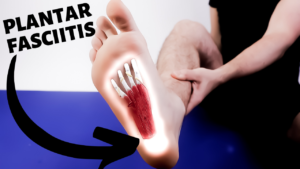
- It is said that 10-40% of people in the world will have chronic heel pain.
- 93% of that is said to be plantar fasciitis.
- This is the most common cause of heel pain in the world.
- It is said that 44% of all foot clinic visits are related to a combination of plantar fasciitis.
- If you have a bottom of the foot and heel pain during the morning, this is likely plantar fasciitis!
- This usually gets better after 10-20 morning steps but then hurts the next morning.
2) Achilles Tendinitis & Back of the Heel Pain:
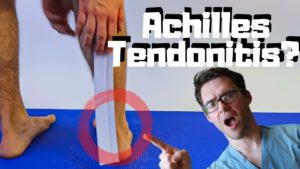
- This is the most common cause of pain in the back of the heel. It is possible to develop heel spur and rest soreness at the site of the Achilles tendon inserts.
- It is also possible to have it about 2 to 6 cm above the heel bone (Called the middle of the Achilles tendon pain).
- It is also possible to strain the actual calf muscle, but it is not Achilles tendinitis, not heel pain.
- This is perhaps the most important ended in the body in terms of bearing weight.
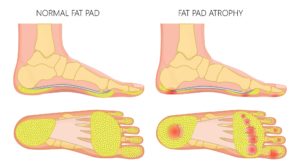
- Common in older people common and those who have had steroid injections, it is thought that he can start at 40, but it does continue later in life.
- We see this most commonly in much older people such as the 60s, 70s, 80s, and higher.
- If you are younger, it is doubtful that this is your problem.
- This is usually achy, burning pain that gets worse during the day.
- This is a widespread condition that we see overall, and it does need to be treated effectively!

- This is increased pain while you are bearing weight.
- These are typical during running sports and repetitive shocked heels.
- It is tested by checking side to side squeeze of the heel bone.
- The calcaneal squeeze test is critical in confirming that heel stress fracture.
- Click on the above link to make sure this is not your problem!
5) Radiculopathy (Back Pain):
- If you have ever had a back injury or nerve injury to your spine, you may have radiculopathy pain.
- This can cause numbness, burning, and tingling-type pain.
- We see this very commonly in people who have soreness and pain in both feet.
- If you have a prior back injury or surgery, this may be your problem.
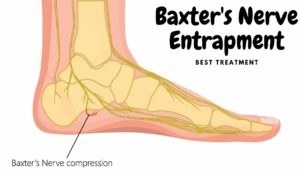
- Baxter’s nerve compression and entrapment is not the most common cause of heel nerve pain.
- Some sources even say Baxter’s nerve compression can be involved in up to 20% of heel pain cases!
- This can result in more nighttime pain, as well as pain during rest.
- If you have numbness, burning, and tingling, it may be Baxter’s pinched nerve in the heel!
